
Chapter 4--Accounting for Merchandising Businesses
Student: ___________________________________________________________________________
1. Operating expenses are subtracted from fees earned for a service business and from gross profit for a
4. Net income or loss may appear on the income statement of both a service business and a merchandising
5. On the income statement, sales returns and allowances and sales discounts are added to gross sales to yield
6. On the income statement, sales discounts are normally deducted from sales to yield the cost of merchandise
7. On the income statement, the merchandise inventory at the beginning of the period is added to sales to yield

8. On the income statement in the single-step form, the total of all expenses is deducted from the total of all
9. A criticism of the single-step income statement is that gross profit and income from operations are not readily
16. The indirect method of preparing the statement of cash flows reconciles net income with net cash flows

19. In a multiple-step income statement, sales will be reduced by sales discounts and sales returns and
23. If payment is due by the end of the month in which the sale is made, the invoice terms are expressed as

27. Sales to customers who use bank credit cards, such as MasterCard and VISA, are generally treated as credit
28. The document issued by the seller that informs the buyer of the details of sales returns is called a debit
29. The effect of a sales return and allowance is a reduction in sales revenue and a decrease in cash or accounts
30. When the seller offers a sales discount, even if borrowing has to be done, it is generally advantageous for
31. If merchandise costing $2,500, terms FOB destination, 2/10, n/30, with prepaid transportation costs of $100,
32. A buyer who acquires merchandise under credit terms of 1/10, n/30 has 30days after the invoice date to take
33. Available discounts taken by the buyer for early payment of an invoice are termed sales discounts by the
34. Purchases of merchandise increase the merchandise inventory account under the perpetual inventory

35. A buyer who acquires merchandise under credit terms of 1/10, n/30 has 10 days after the invoice date to
37. In a perpetual inventory system, merchandise returned to vendors reduces the merchandise inventory
39. If the ownership of merchandise passes to the buyer when the seller delivers the merchandise for shipment,
40. Merchandise is sold for $2,500, terms FOB destination, 2/10, n/30, with transportation costs of $150. If
$500 of the merchandise is returned prior to payment and the invoice is paid within the discount period, the
42. If merchandise costing $2,500, terms FOB destination, 2/10, n/30, with transportation costs of $100, is paid
43. When someone purchases merchandise and incurs the cost of transportation, these costs of purchasing
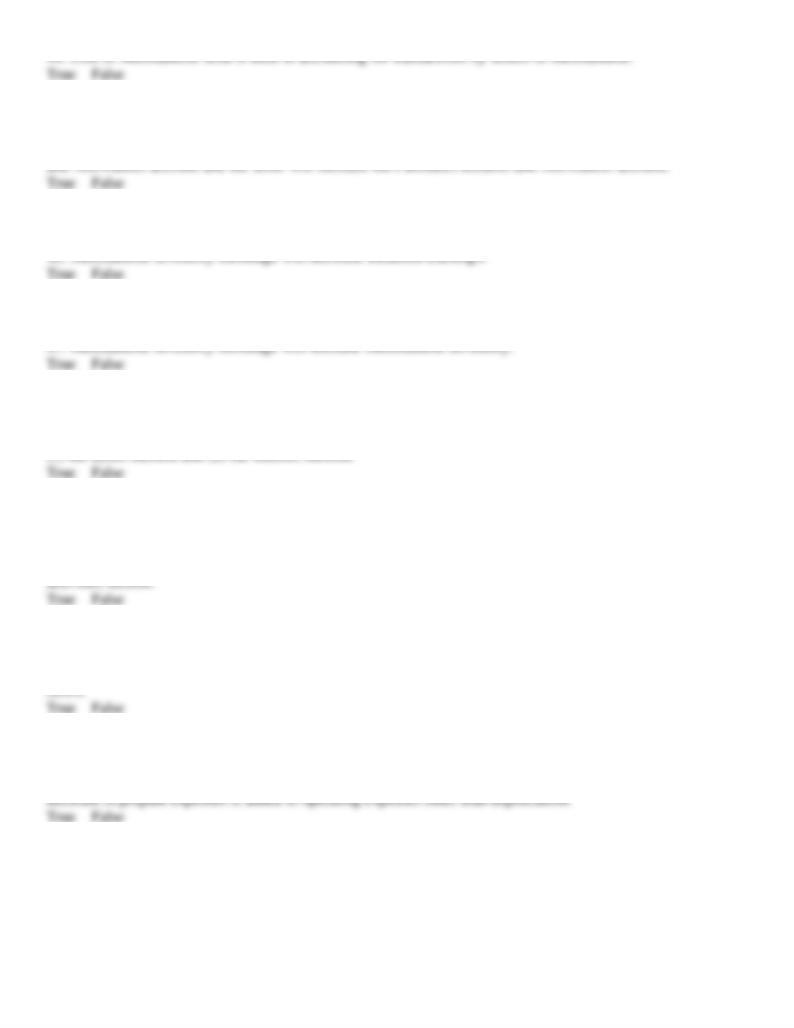
45. In a transaction where purchased merchandise has been returned, the buyer will increase the Sales Returns
48. There are two alternatives to reporting cash flows from operating activities in the statement of cash flows:
49. If cash dividends of $145,000 were declared during the year and the decrease in dividends payable from the
beginning to the end of the year was $7,000, the statement of cash flows would report $152,000 in the financing
50. Repayments of bonds would be shown as a cash outflow in the investing section of the statement of cash
51. To determine cash payments for operating expenses for the cash flow statement using the direct method, a
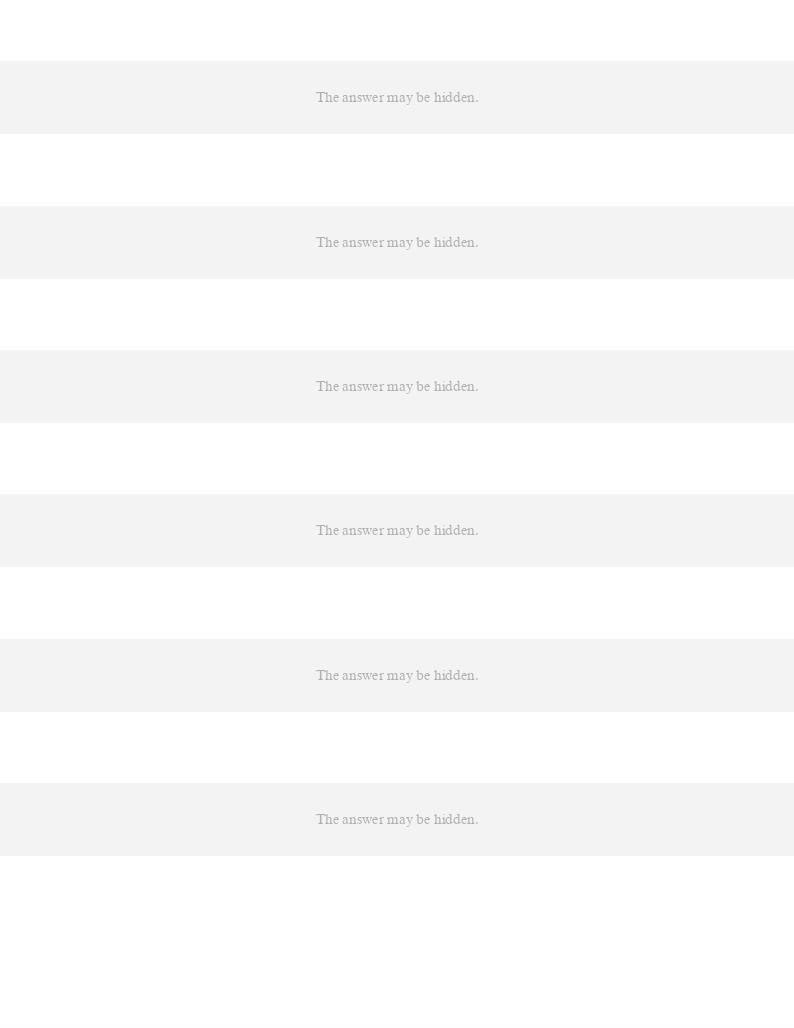
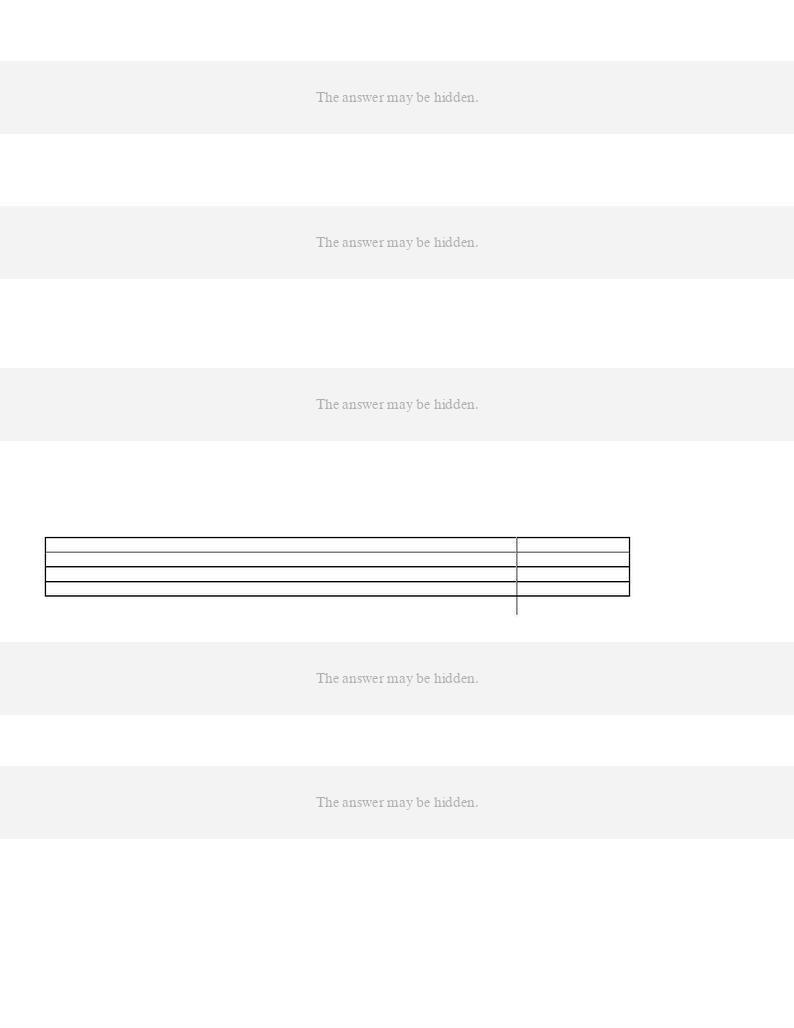
60. East, Inc. had beginning inventory of $10,000, purchases of $25,000, and ending inventory of $5,000. What
61. Dig, Inc. had the following merchandise transactions in October:
Purchases
$50,000
Purchase returns
$ 4,000
Purchase discounts
$ 1,000
Transportation in
$ 2,000
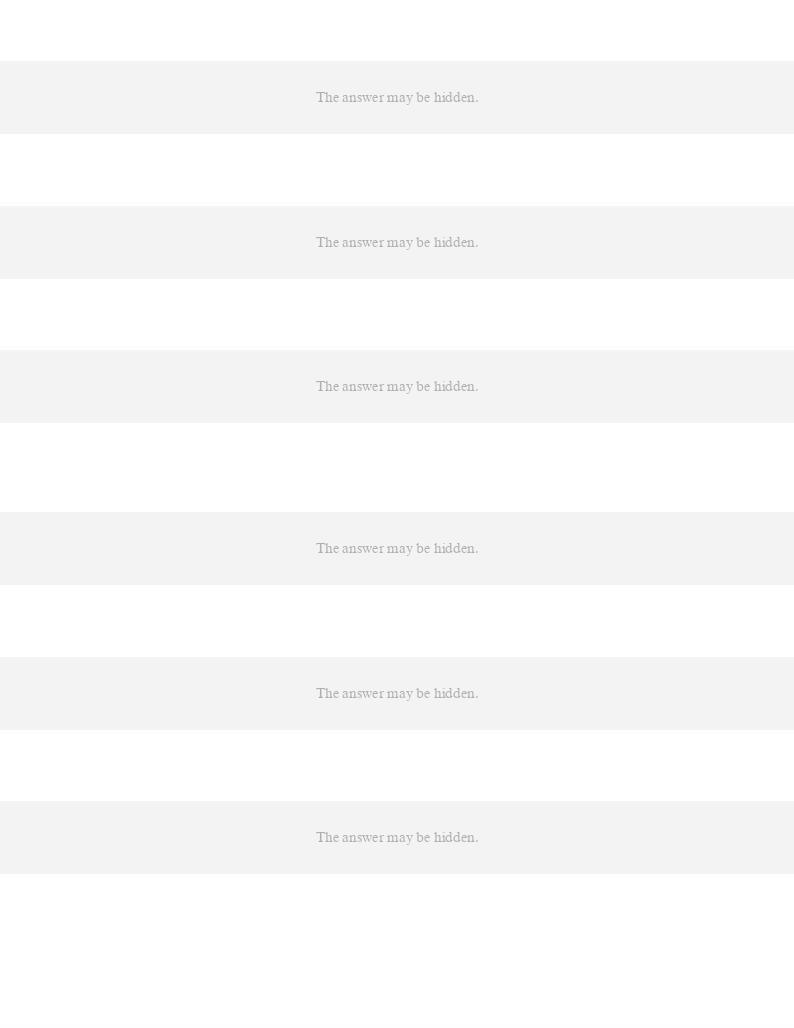
66. NBC Company had $32,000 in net sales, $15,000 in cost of merchandise sold, $18,000 in operating
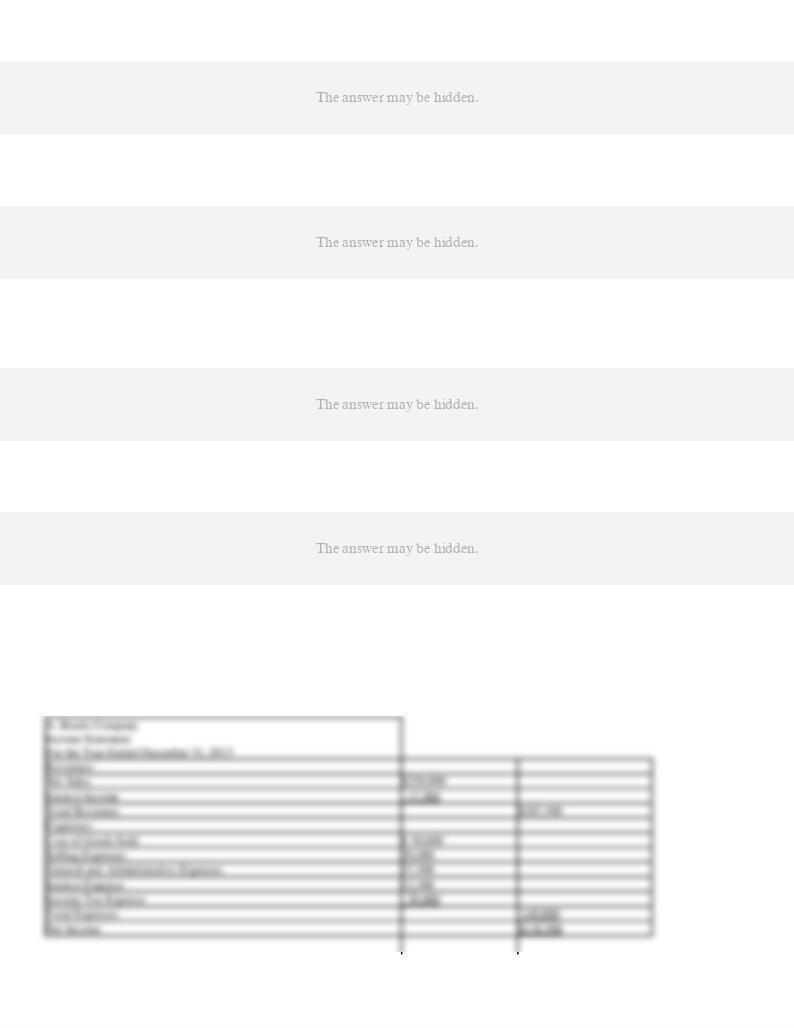
71. The form of income statement that derives its name from the fact that the total of all expenses is deducted
73. A. Bonds Company
The following is a single-step income statement for the A. Bonds Company:
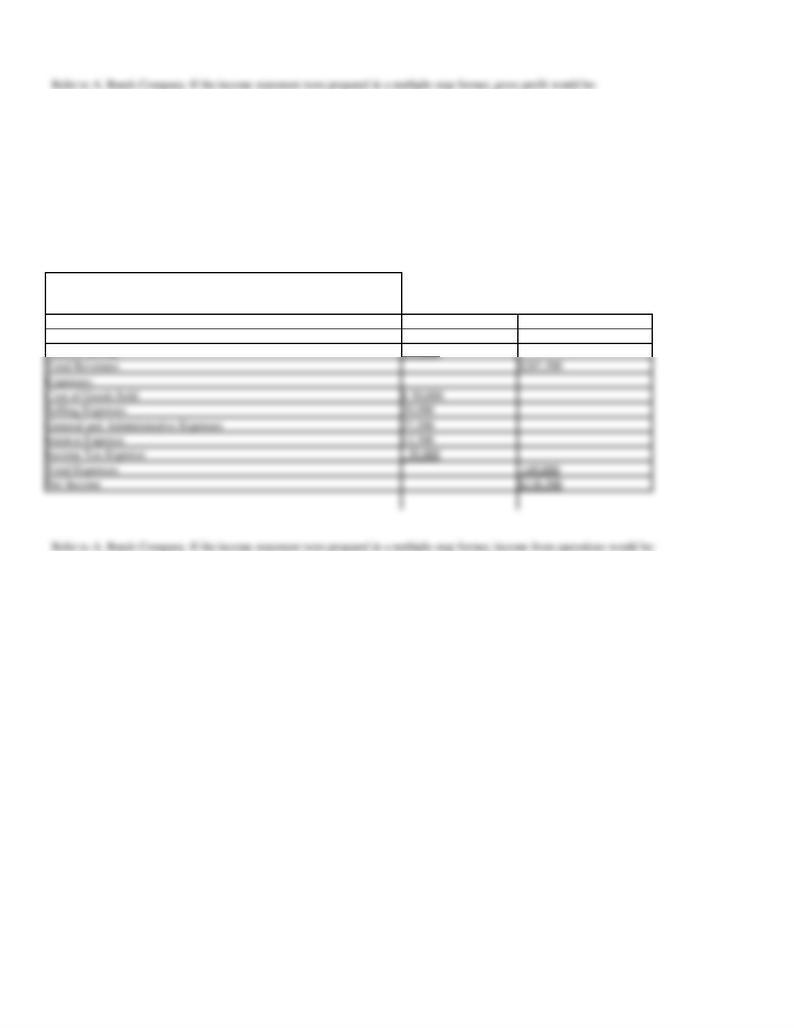
A. $200,000.
B. $127,500.
C. $101,000.
D. $152,500.
74. A. Bonds Company
The following is a single-step income statement for the A. Bonds Company:
A. Bonds Company
Income Statement
For the Year Ended December 31, 2013
Revenues:
Net Sales
$250,000
Interest Income
17,500
A. $101,000.
B. $113,500.
C. $118,500.
D. $152,500.
75. Which of the following would be subtracted from gross profit to determine operating income?
A. Operating expenses
B. Other expenses
C. Income taxes
D. All of these
76. Merchandise not sold at the end of the period is reported as:
A. cost of goods sold.
B. old stock.
C. merchandise inventory.
D. net purchases.

80. Deana, Inc.
Deana, Inc. purchased merchandise for $500,000, received credit for purchase returns of $25,000, took purchase
discounts of $10,000, and paid transportation in of $20,000.
81. Deana, Inc.
Deana, Inc. purchased merchandise for $500,000, received credit for purchase returns of $25,000, took purchase
discounts of $10,000, and paid transportation in of $20,000.
Refer to Deana, Inc. If Deana, Inc. had $20,000 in beginning inventory, and sold goods costing $300,000, what

83. Which of the following accounts will not be found in the Cost of Merchandise Sold section on the income
87. Gold Co. sold merchandise to Bronze Co. on account, $25,000, terms 2/15, net 45. The cost of the
merchandise sold is $18,500. Gold Co. issued a credit memorandum for $2,500 for merchandise returned that
originally cost $1,900. Bronze Co. paid the invoice within the discount period. What is amount of net sales from
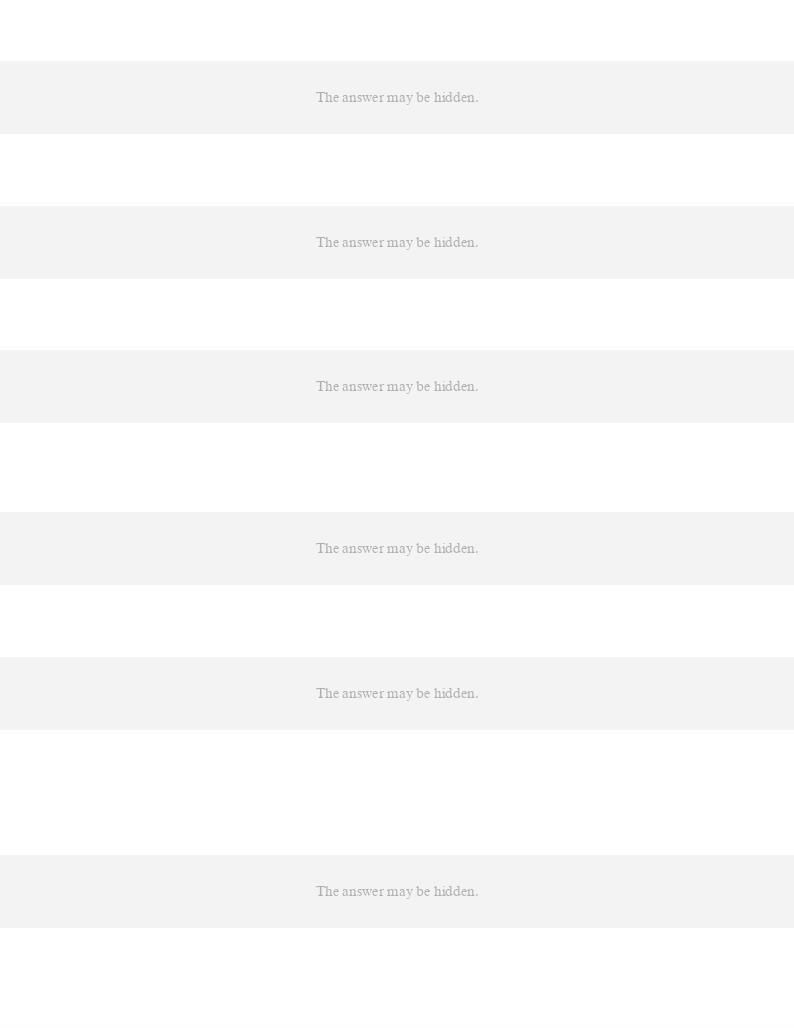
91. If Martin, Inc. sold $550,000 worth of merchandise, had $50,000 returned, and then the balance paid during
93. Merchandise is ordered on November 12; the merchandise is shipped by the seller and the invoice is
prepared, dated, and mailed by the seller on November 15; the merchandise is received by the buyer on
November 17; the transaction is recorded in the buyer's accounts on November 18. The credit period begins

94. Merchandise is ordered on November 12; the merchandise is shipped by the seller and the invoice is
prepared, dated, and mailed by the seller on November 15; the merchandise is received by the buyer on
November 17; the transaction is recorded in the seller's accounts on November 15. If the credit terms are 1/10,
95. A sales invoice included the following information: merchandise price, $4,500; transportation, $300; terms
1/10, n/eom, FOB shipping point. Assuming that a credit for merchandise returned of $600 is granted prior to
payment, that the transportation is prepaid by the seller, and that the invoice is paid within the discount period,
96. Sometimes a(n) _____ is offered to buyers as a means of encouraging them to pay before the end of the
98. If a $20,000 sale is made on January 1, with terms of 2/10, n/30, how much would the discount be if

101. In recording the cost of merchandise sold for cash using a perpetual inventory system, the effect on the
103. For the perpetual inventory system, which of the following effects does not occur upon the return from a
104. If merchandise sold on account is returned to the seller, the seller may inform the customer of the details
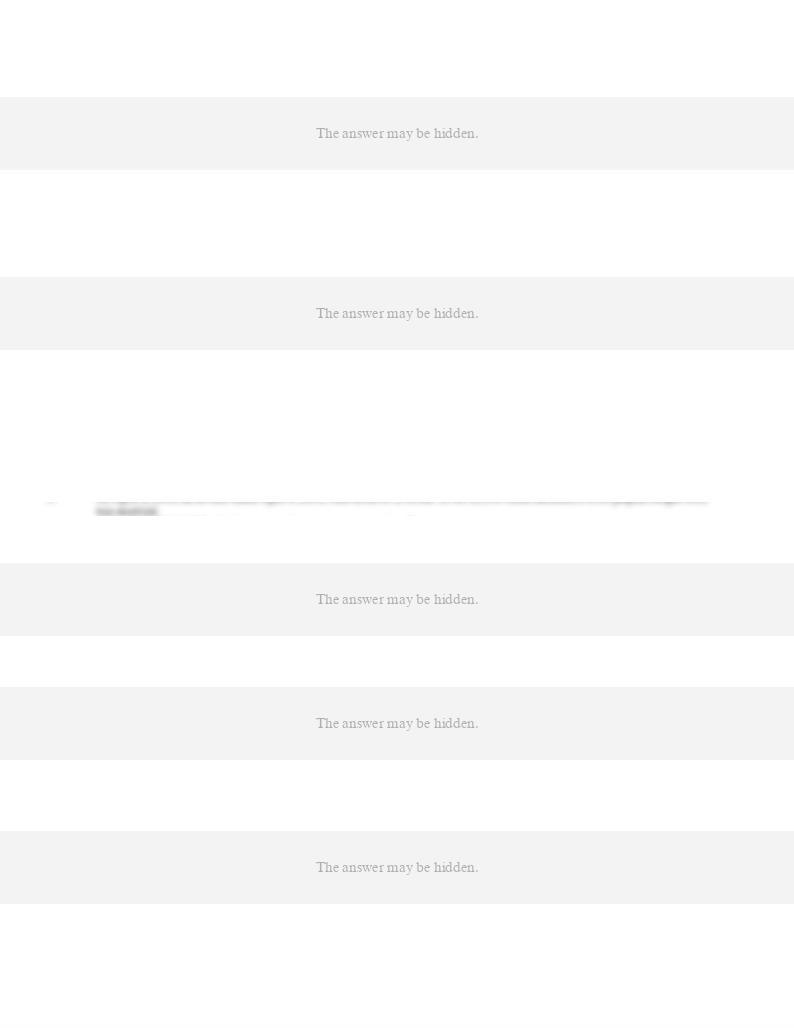
105. Merchandise subject to terms 1/10, n/30, FOB shipping point, is sold on account to a customer for $20,000.
The seller issued a credit memorandum for $5,000 prior to payment. What is the amount of the cash discount
106. Orange Co. sells merchandise on credit to Zea Co. in the amount of $9,000. The invoice is dated on
September 15 with terms of 1/15, net 45. What is the amount of the discount, and up to what date must the
107. Based on the following information, what would be recorded as purchases discount if the invoice is paid
within the discount period?
1.
$5,000 of merchandise inventory was ordered on April 2, 2010.
2.
$2,000 of this merchandise was received on April 5, 2010.
4.
On April 10, 2010, $500 of the merchandise was returned to the seller.
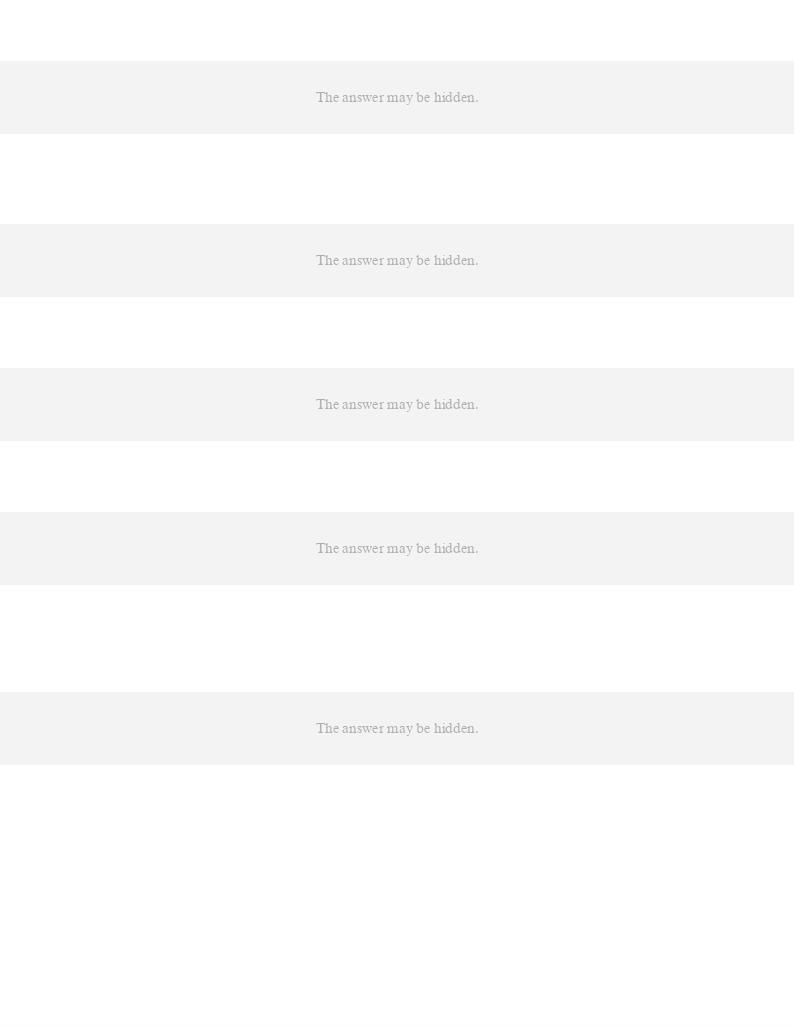
111. Using a perpetual inventory system, the purchase of $30,000 of merchandise on account would include
114. A sales invoice included the following information: merchandise price, $5,000; terms 1/10, n/eom.
Assuming that a credit for merchandise returned of $600 is granted prior to payment, and that the invoice is paid

115. A sales invoice included the following information: merchandise price, $6,000; terms 2/10, n/eom.
Assuming that a credit for merchandise returned of $600 is granted prior to payment, and that the invoice is paid
116. Merchandise subject to terms 1/10, n/30, FOB shipping point, is sold on account to a customer for $17,500.
The seller issued a credit memorandum for $4,000 prior to payment. What is the amount of the cash discount
119. If title to merchandise purchases passes to the buyer when the goods are shipped from the seller, the terms
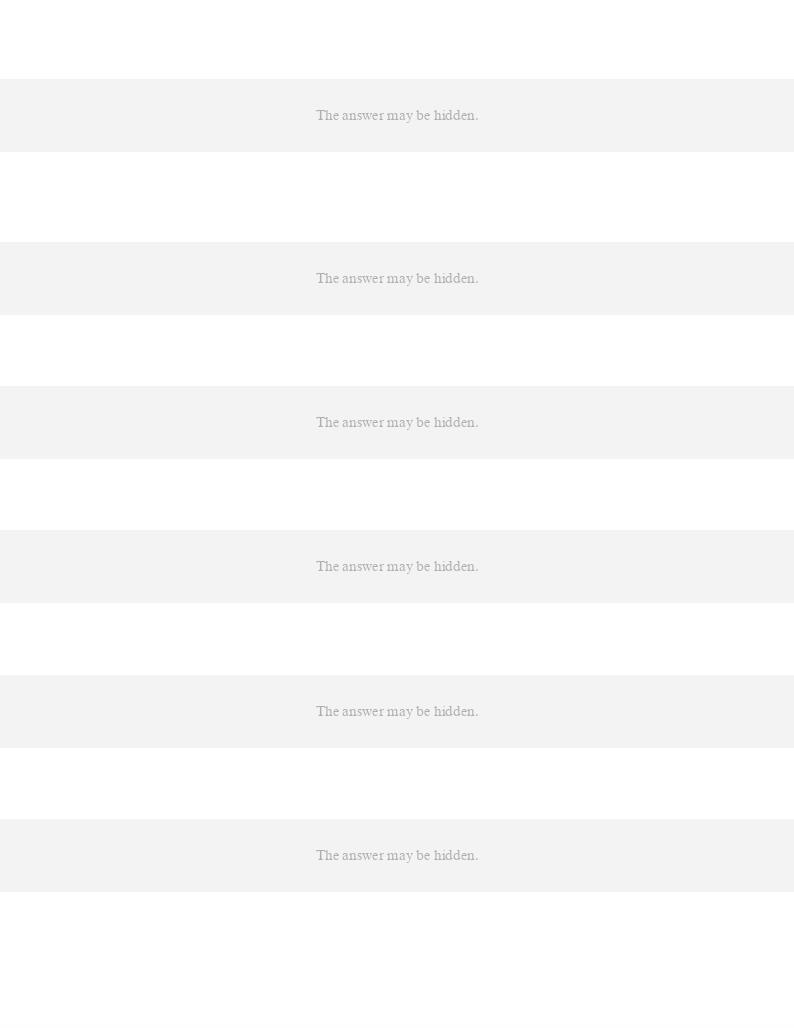
120. If title to merchandise purchases passes to the buyer when the goods are delivered to the buyer, the terms
121. Merchandise with an invoice price of $6,000 is purchased subject to terms of 2/10, n/30, FOB destination.

126. Under the indirect method for preparing the statement of cash flows, increases in current liabilities are
127. Which of the following would not affect the operating activities section of the statement of cash flows,
128. A company has a net income of $39,000 and depreciation expenses of $9,000. During the year, its accounts
payable balance decreased by $5,000. What is the net cash flow from operating activities using the indirect
129. Under the indirect method for preparing the statement of cash flows, decreases in current assets are _____

131. ONI, Inc. purchased $60,000 of equipment for cash. How does this transaction impact the statement of
133. The following data for the year ended June 30, 2013, were extracted from the accounting records of Roof
Co.:
134. The following data for the current year ended December 31, 2013, were extracted from the accounting
records of Gilbert Co.:
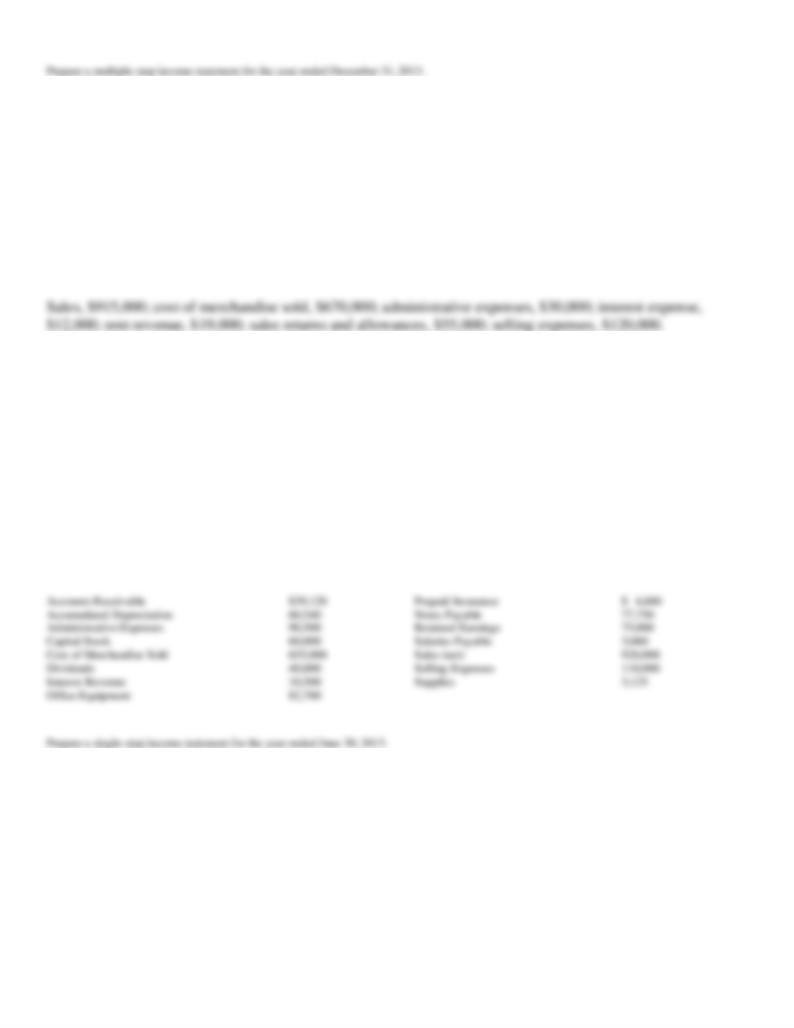
135. Prepare a multiple-step income statement for Surry Co. from the following data for the year ended
December 31, 2013.
136. Selected data from the ledger of Wiles Co. after adjustment at June 30, the end of the fiscal year, are listed
as follows:
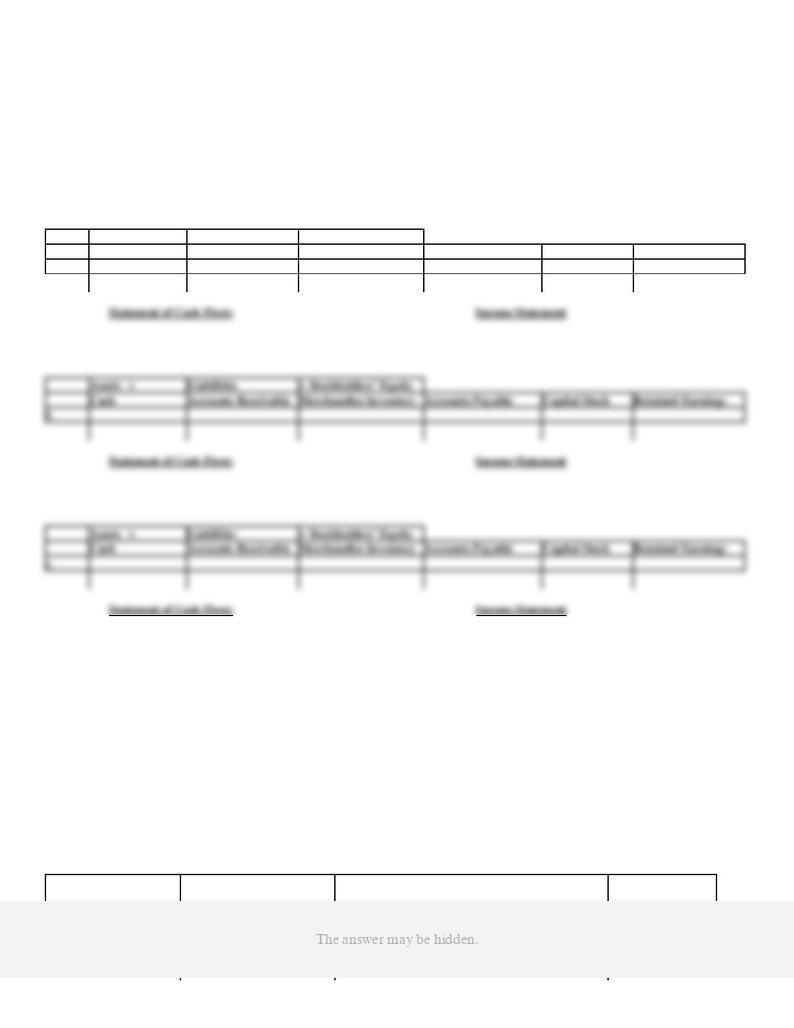
137. Merchandise with a list price of $7,500 and a cost of $7,000 is sold on account, terms 1/10, n/30. Prior to
payment, merchandise with a list price of $1,000 and a cost of $800 is returned. The correct amount is paid
within the discount period.
Record the following transactions, using the integrated financial statement framework that follows:
(a)
Sold the merchandise.
(b)
Received the returned merchandise
(c)
Received the amount owed.
Assets =
Liabilities
+ Stockholders' Equity
Cash
Accounts Receivable
Merchandise Inventory
Accounts Payable
Capital Stock
Retained Earnings
a.
138. Details of invoices for purchases of merchandise are as follows:
Merchandise
Transportation
Terms
Returns and
Allowances

139. Based on the information below, illustrate the effects on the accounts and financial statements of the Seller
and the Buyer. Both use a perpetual inventory system.
(a)
Seller sells Buyer on account merchandise costing $300 for $500, terms 2/10, net 30, FOB destination. The transportation charge is $50.
(b)
Buyer returns as defective $100 worth of the $500 merchandise received. The seller's cost is $60.
(c)
Buyer pays within the discount period.
(a) Seller
Assets =
Liabilities
+ Stockholders'
Equity
Cash
Accounts
Receivable
Merchandise
Inventory
Accounts
Payable
Capital
Stock
Retained
Earnings
Statement of Cash Flows
Income Statement
(a) Buyer
Assets =
Liabilities
+ Stockholders'
Equity
Cash
Accounts
Receivable
Merchandise
Inventory
Accounts
Payable
Capital
Stock
Retained
Earnings
Statement of Cash Flows
Income Statement
(b) Seller
Assets =
Liabilities
+ Stockholders'
Equity
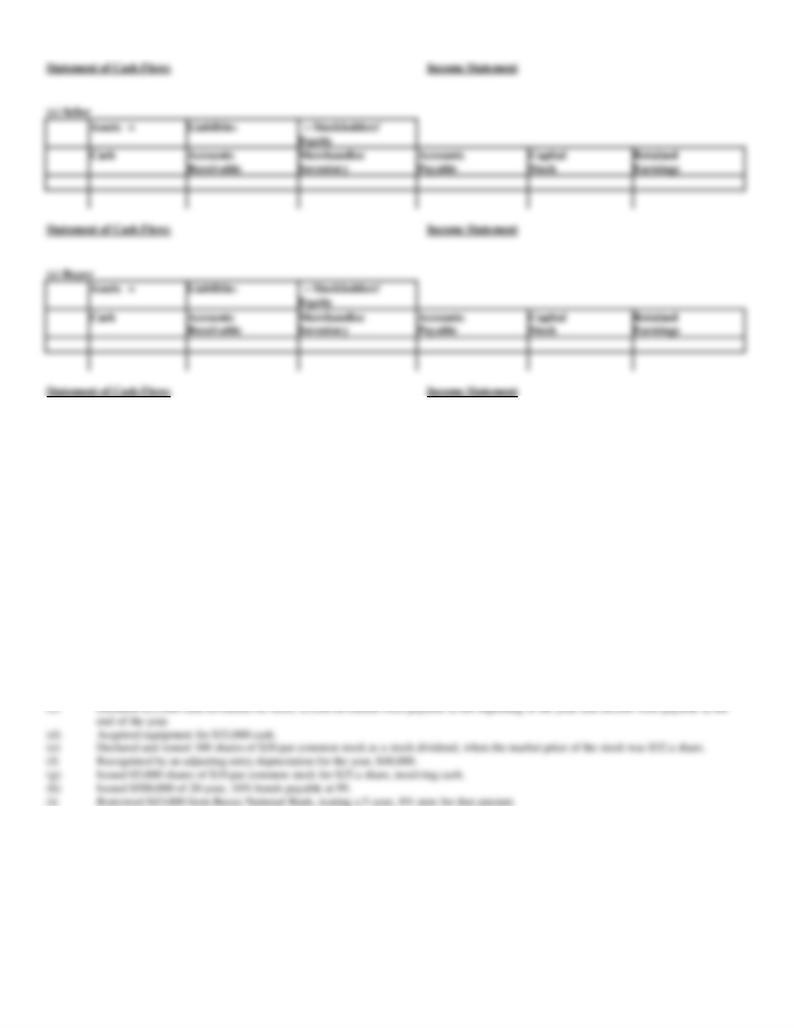
140. State the section(s) of the statement of cash flows prepared by the indirect method (operating activities,
investing activities, financing activities, or not reported) and the amount that would be reported for each of the
following transactions:
(a)
Received $145,000 from the sale of land costing $70,000.
(b)
Purchased investments for $50,000.

141. Gold Co. sold merchandise to Bronze Co. on account, $23,000, terms 2/15, net 45. The cost of the
merchandise sold is $18,500. Gold Co. issued a credit memorandum for $2,500 for merchandise returned that
originally cost $1,900. Bronze Co. paid the invoice within the discount period. What is the amount of net
income earned by Gold Co. on the transactions?
142. Based on the following data, determine the cost of merchandise sold for October.

Chapter 4--Accounting for Merchandising Businesses Key
1. Operating expenses are subtracted from fees earned for a service business and from gross profit for a
4. Net income or loss may appear on the income statement of both a service business and a merchandising
5. On the income statement, sales returns and allowances and sales discounts are added to gross sales to yield
6. On the income statement, sales discounts are normally deducted from sales to yield the cost of merchandise
7. On the income statement, the merchandise inventory at the beginning of the period is added to sales to yield
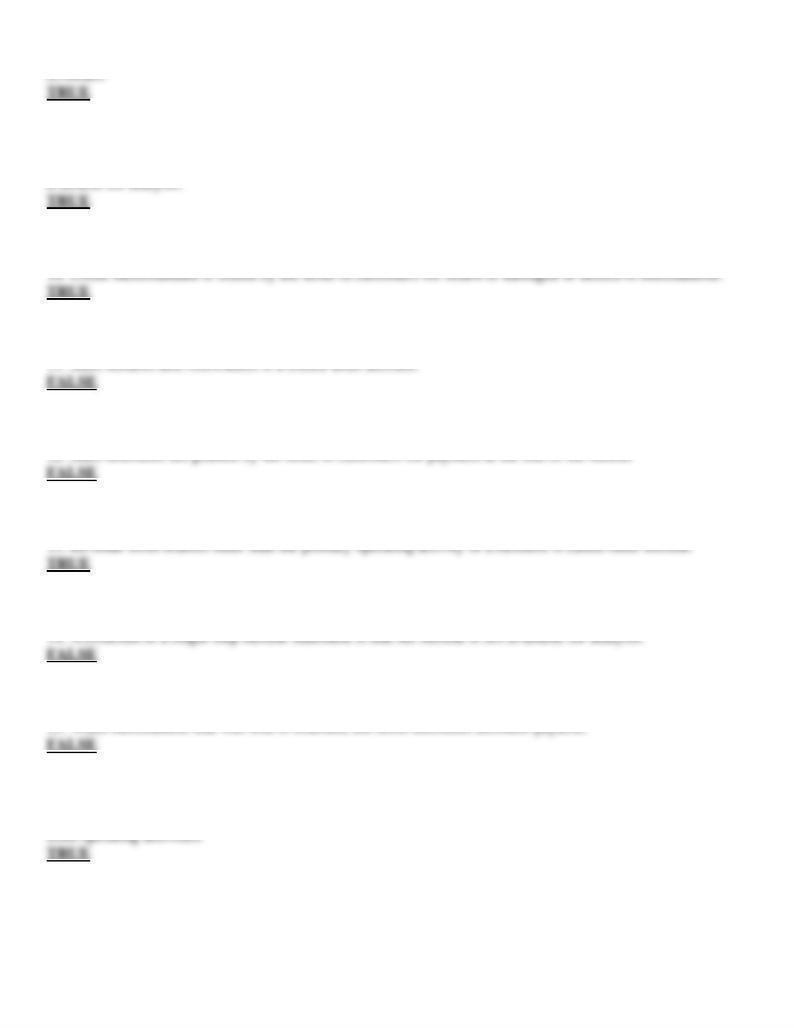
8. On the income statement in the single-step form, the total of all expenses is deducted from the total of all
9. A criticism of the single-step income statement is that gross profit and income from operations are not readily
16. The indirect method of preparing the statement of cash flows reconciles net income with net cash flows
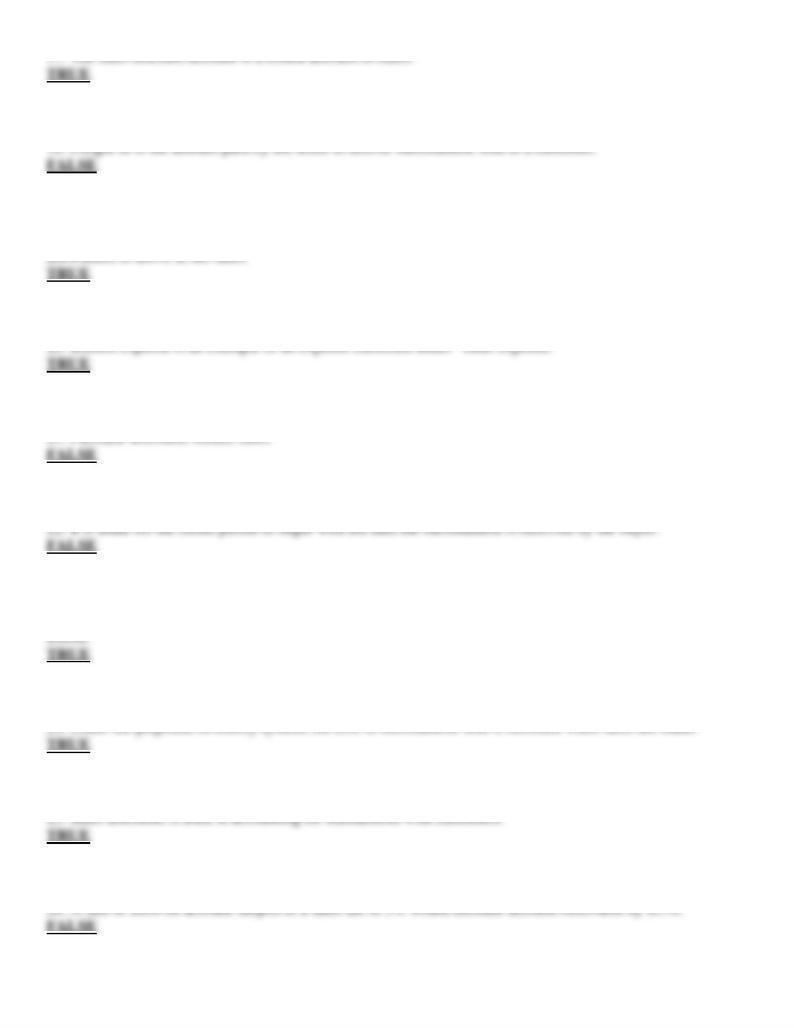
19. In a multiple-step income statement, sales will be reduced by sales discounts and sales returns and
23. If payment is due by the end of the month in which the sale is made, the invoice terms are expressed as
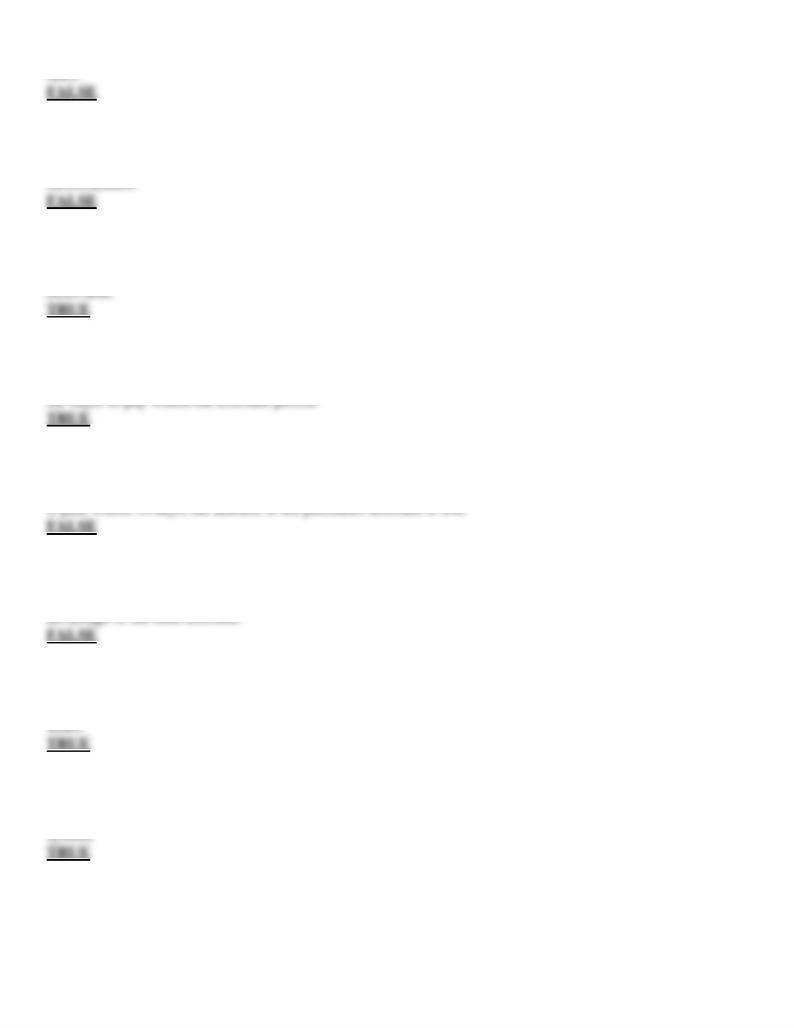
27. Sales to customers who use bank credit cards, such as MasterCard and VISA, are generally treated as credit
28. The document issued by the seller that informs the buyer of the details of sales returns is called a debit
29. The effect of a sales return and allowance is a reduction in sales revenue and a decrease in cash or accounts
30. When the seller offers a sales discount, even if borrowing has to be done, it is generally advantageous for
31. If merchandise costing $2,500, terms FOB destination, 2/10, n/30, with prepaid transportation costs of $100,
32. A buyer who acquires merchandise under credit terms of 1/10, n/30 has 30days after the invoice date to take
33. Available discounts taken by the buyer for early payment of an invoice are termed sales discounts by the
34. Purchases of merchandise increase the merchandise inventory account under the perpetual inventory
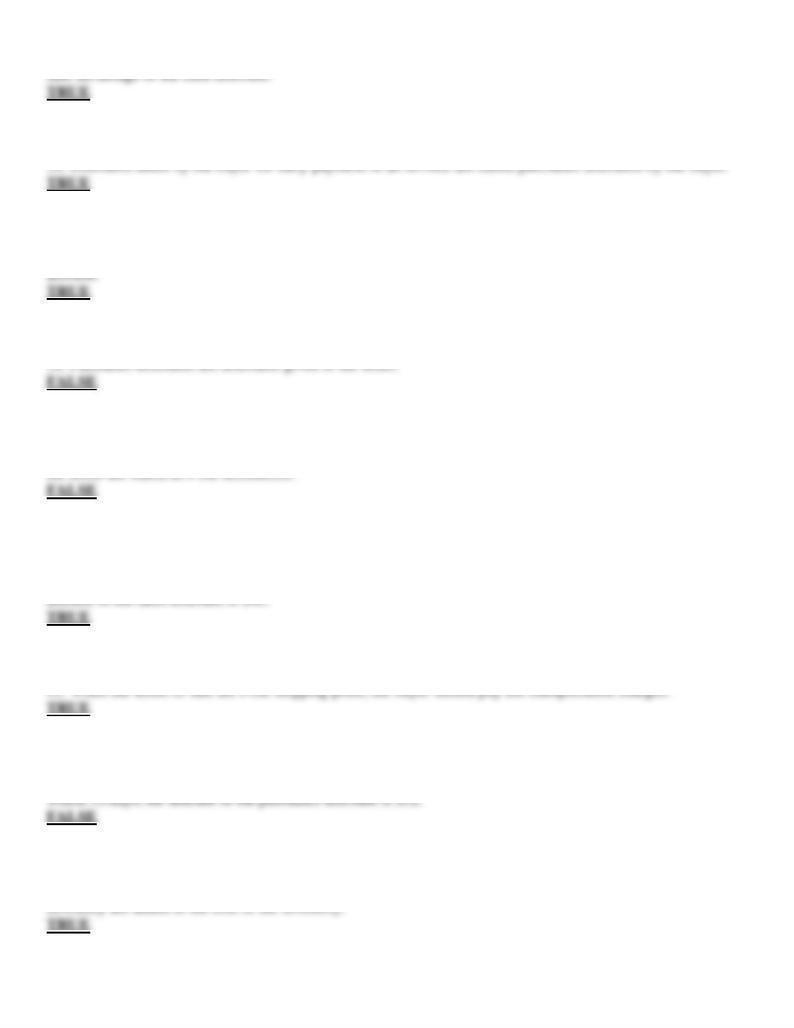
35. A buyer who acquires merchandise under credit terms of 1/10, n/30 has 10 days after the invoice date to
37. In a perpetual inventory system, merchandise returned to vendors reduces the merchandise inventory
39. If the ownership of merchandise passes to the buyer when the seller delivers the merchandise for shipment,
40. Merchandise is sold for $2,500, terms FOB destination, 2/10, n/30, with transportation costs of $150. If
$500 of the merchandise is returned prior to payment and the invoice is paid within the discount period, the
42. If merchandise costing $2,500, terms FOB destination, 2/10, n/30, with transportation costs of $100, is paid
43. When someone purchases merchandise and incurs the cost of transportation, these costs of purchasing

45. In a transaction where purchased merchandise has been returned, the buyer will increase the Sales Returns
48. There are two alternatives to reporting cash flows from operating activities in the statement of cash flows:
49. If cash dividends of $145,000 were declared during the year and the decrease in dividends payable from the
beginning to the end of the year was $7,000, the statement of cash flows would report $152,000 in the financing
50. Repayments of bonds would be shown as a cash outflow in the investing section of the statement of cash
51. To determine cash payments for operating expenses for the cash flow statement using the direct method, a
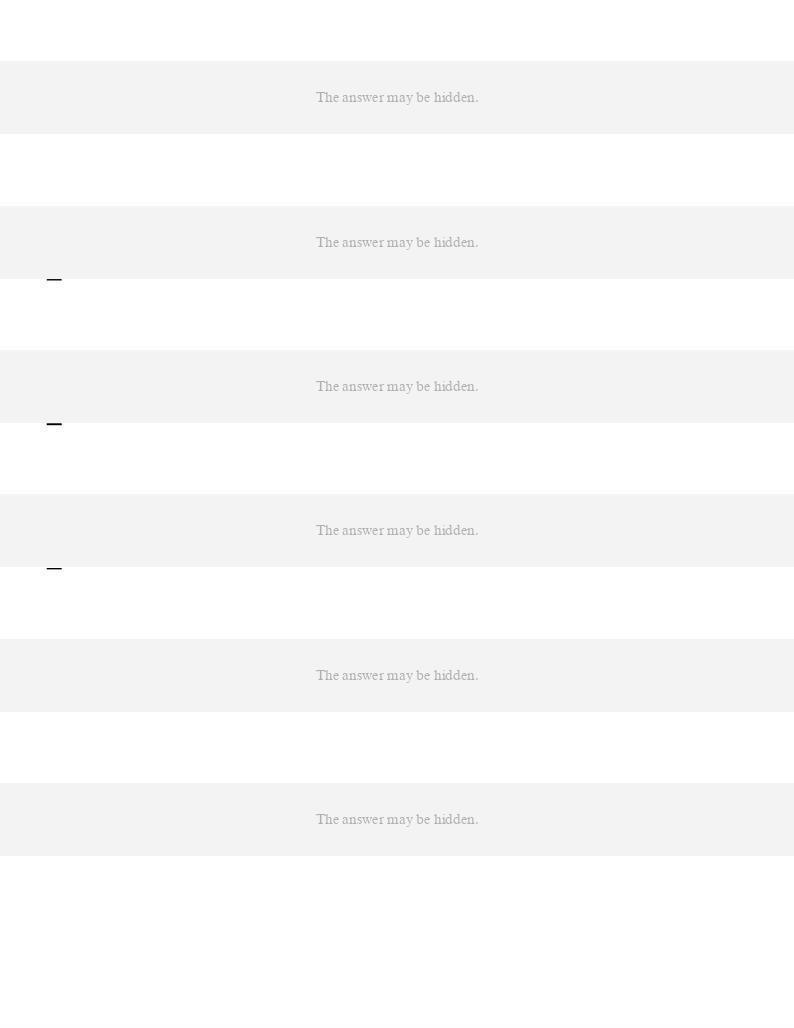

60. East, Inc. had beginning inventory of $10,000, purchases of $25,000, and ending inventory of $5,000. What
61. Dig, Inc. had the following merchandise transactions in October:
Purchases
$50,000
Purchase returns
$ 4,000
Purchase discounts
$ 1,000
Transportation in
$ 2,000
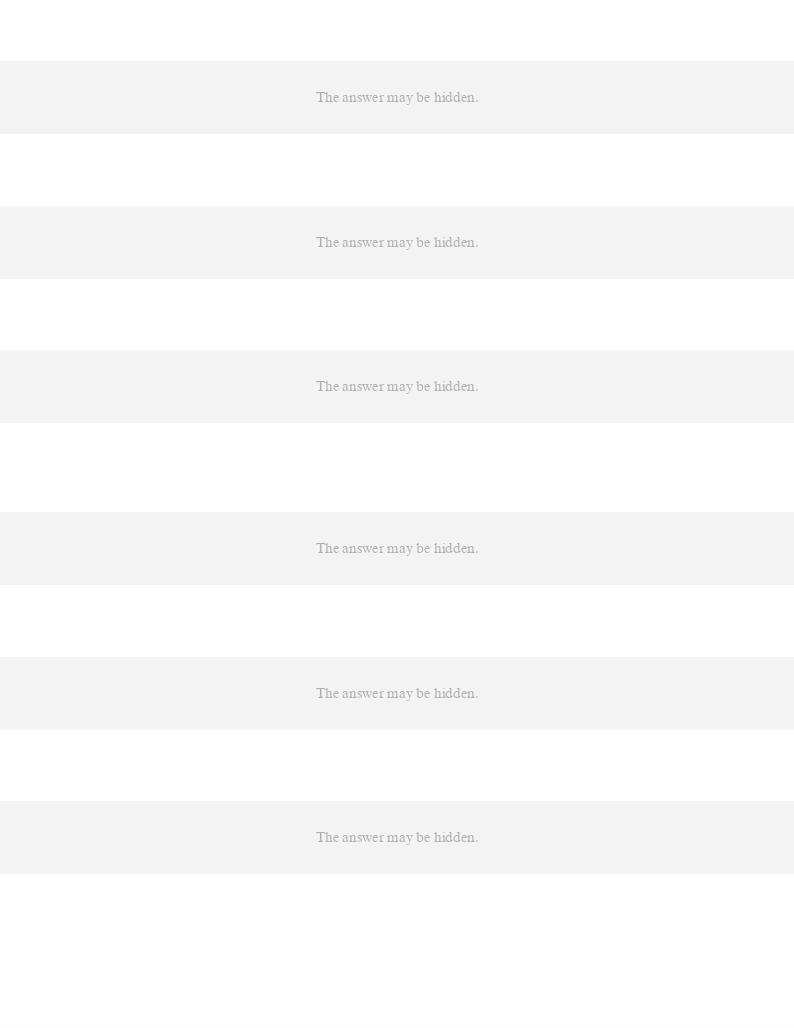
66. NBC Company had $32,000 in net sales, $15,000 in cost of merchandise sold, $18,000 in operating
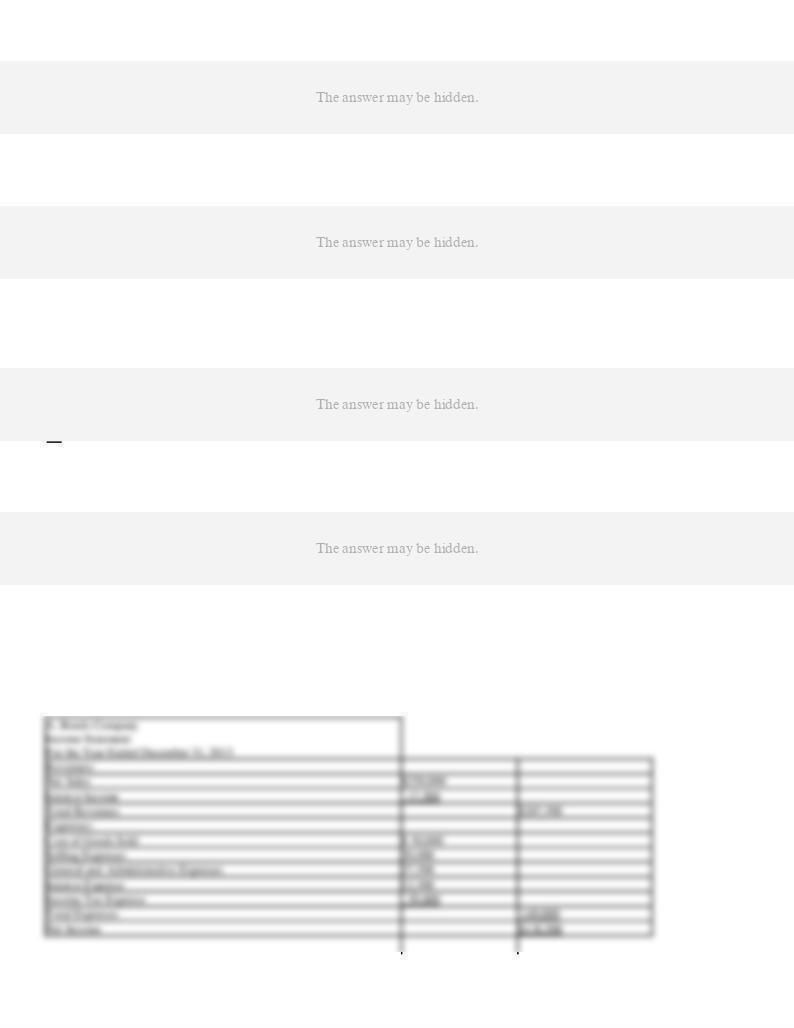
71. The form of income statement that derives its name from the fact that the total of all expenses is deducted
73. A. Bonds Company
The following is a single-step income statement for the A. Bonds Company:

A. $200,000.
B. $127,500.
C. $101,000.
D. $152,500.
74. A. Bonds Company
The following is a single-step income statement for the A. Bonds Company:
A. Bonds Company
Income Statement
For the Year Ended December 31, 2013
Revenues:
Net Sales
$250,000
Interest Income
17,500
A. $101,000.
B. $113,500.
C. $118,500.
D. $152,500.
75. Which of the following would be subtracted from gross profit to determine operating income?
A. Operating expenses
B. Other expenses
C. Income taxes
D. All of these
76. Merchandise not sold at the end of the period is reported as:
A. cost of goods sold.
B. old stock.
C. merchandise inventory.
D. net purchases.
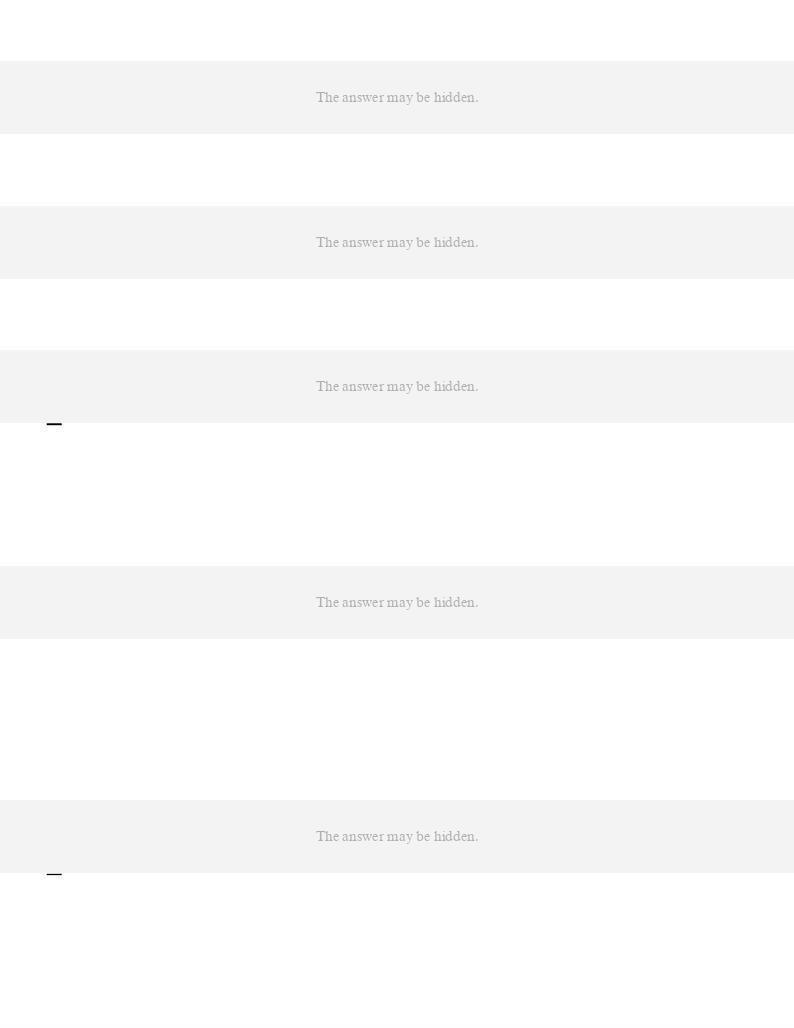
80. Deana, Inc.
Deana, Inc. purchased merchandise for $500,000, received credit for purchase returns of $25,000, took purchase
discounts of $10,000, and paid transportation in of $20,000.
81. Deana, Inc.
Deana, Inc. purchased merchandise for $500,000, received credit for purchase returns of $25,000, took purchase
discounts of $10,000, and paid transportation in of $20,000.
Refer to Deana, Inc. If Deana, Inc. had $20,000 in beginning inventory, and sold goods costing $300,000, what

83. Which of the following accounts will not be found in the Cost of Merchandise Sold section on the income
87. Gold Co. sold merchandise to Bronze Co. on account, $25,000, terms 2/15, net 45. The cost of the
merchandise sold is $18,500. Gold Co. issued a credit memorandum for $2,500 for merchandise returned that
originally cost $1,900. Bronze Co. paid the invoice within the discount period. What is amount of net sales from
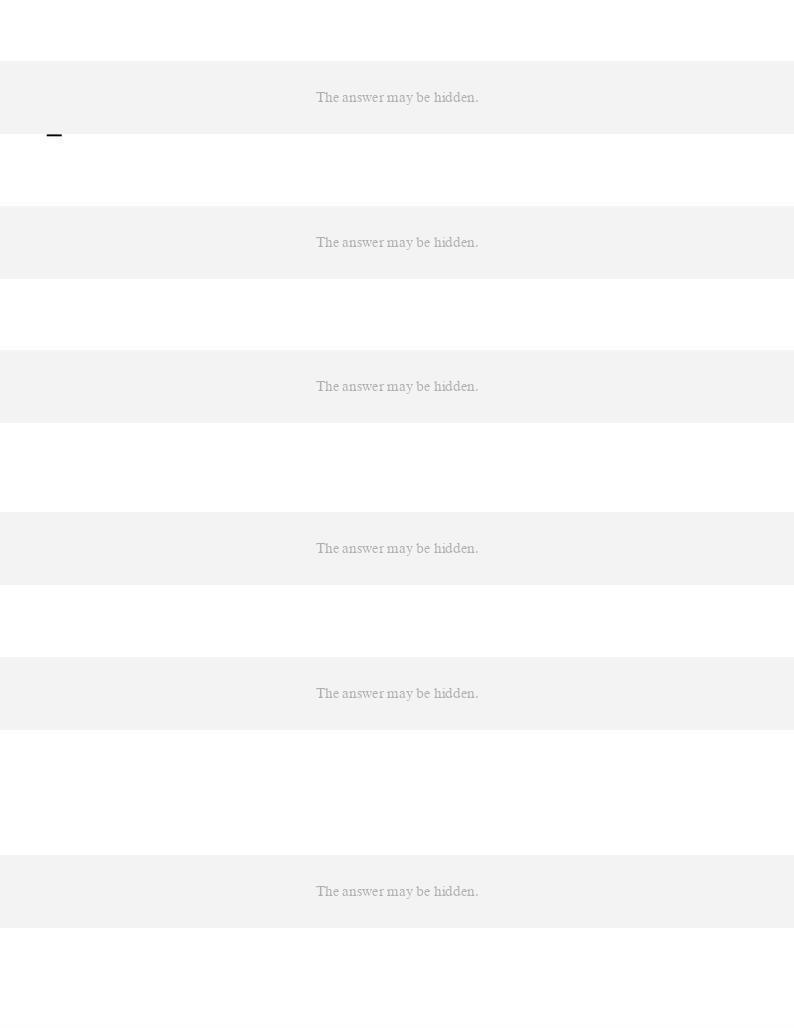
91. If Martin, Inc. sold $550,000 worth of merchandise, had $50,000 returned, and then the balance paid during
93. Merchandise is ordered on November 12; the merchandise is shipped by the seller and the invoice is
prepared, dated, and mailed by the seller on November 15; the merchandise is received by the buyer on
November 17; the transaction is recorded in the buyer's accounts on November 18. The credit period begins

94. Merchandise is ordered on November 12; the merchandise is shipped by the seller and the invoice is
prepared, dated, and mailed by the seller on November 15; the merchandise is received by the buyer on
November 17; the transaction is recorded in the seller's accounts on November 15. If the credit terms are 1/10,
95. A sales invoice included the following information: merchandise price, $4,500; transportation, $300; terms
1/10, n/eom, FOB shipping point. Assuming that a credit for merchandise returned of $600 is granted prior to
payment, that the transportation is prepaid by the seller, and that the invoice is paid within the discount period,
96. Sometimes a(n) _____ is offered to buyers as a means of encouraging them to pay before the end of the
98. If a $20,000 sale is made on January 1, with terms of 2/10, n/30, how much would the discount be if
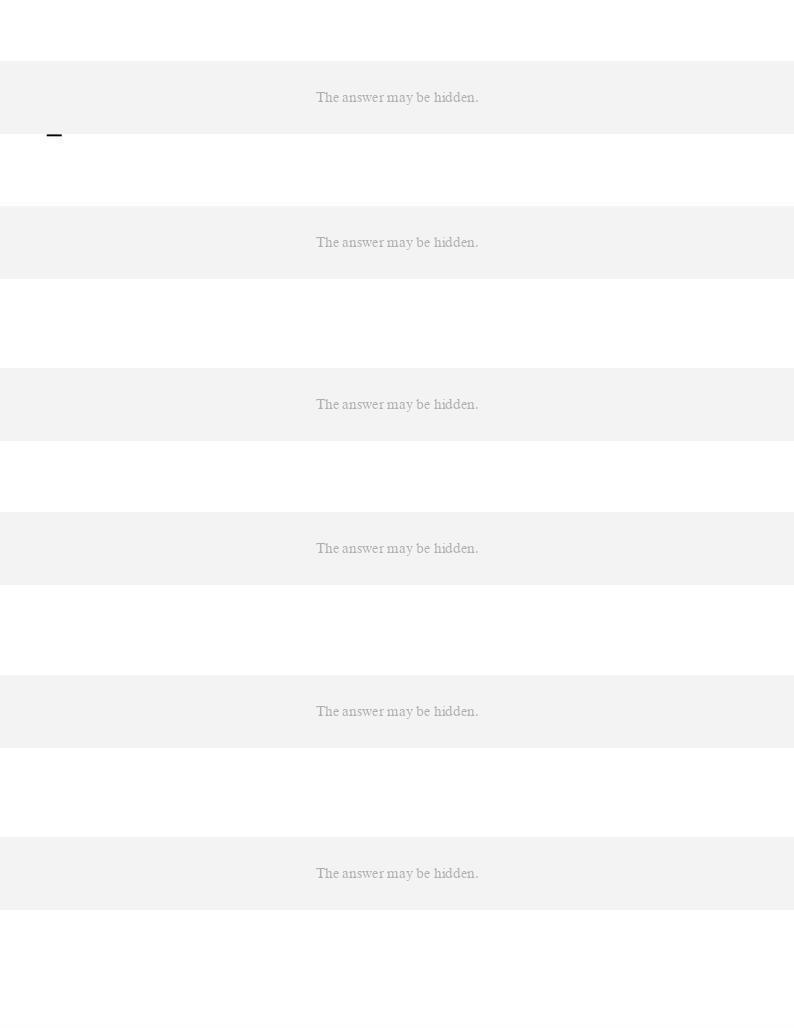
101. In recording the cost of merchandise sold for cash using a perpetual inventory system, the effect on the
103. For the perpetual inventory system, which of the following effects does not occur upon the return from a
104. If merchandise sold on account is returned to the seller, the seller may inform the customer of the details
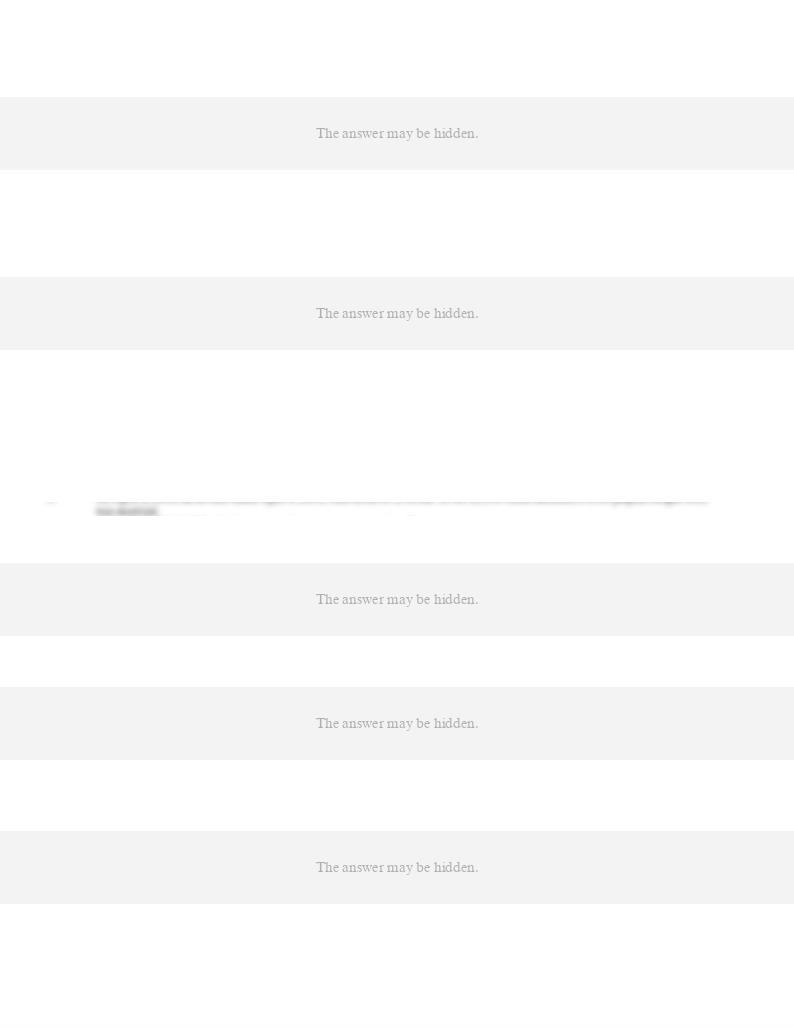
105. Merchandise subject to terms 1/10, n/30, FOB shipping point, is sold on account to a customer for $20,000.
The seller issued a credit memorandum for $5,000 prior to payment. What is the amount of the cash discount
106. Orange Co. sells merchandise on credit to Zea Co. in the amount of $9,000. The invoice is dated on
September 15 with terms of 1/15, net 45. What is the amount of the discount, and up to what date must the
107. Based on the following information, what would be recorded as purchases discount if the invoice is paid
within the discount period?
1.
$5,000 of merchandise inventory was ordered on April 2, 2010.
2.
$2,000 of this merchandise was received on April 5, 2010.
4.
On April 10, 2010, $500 of the merchandise was returned to the seller.
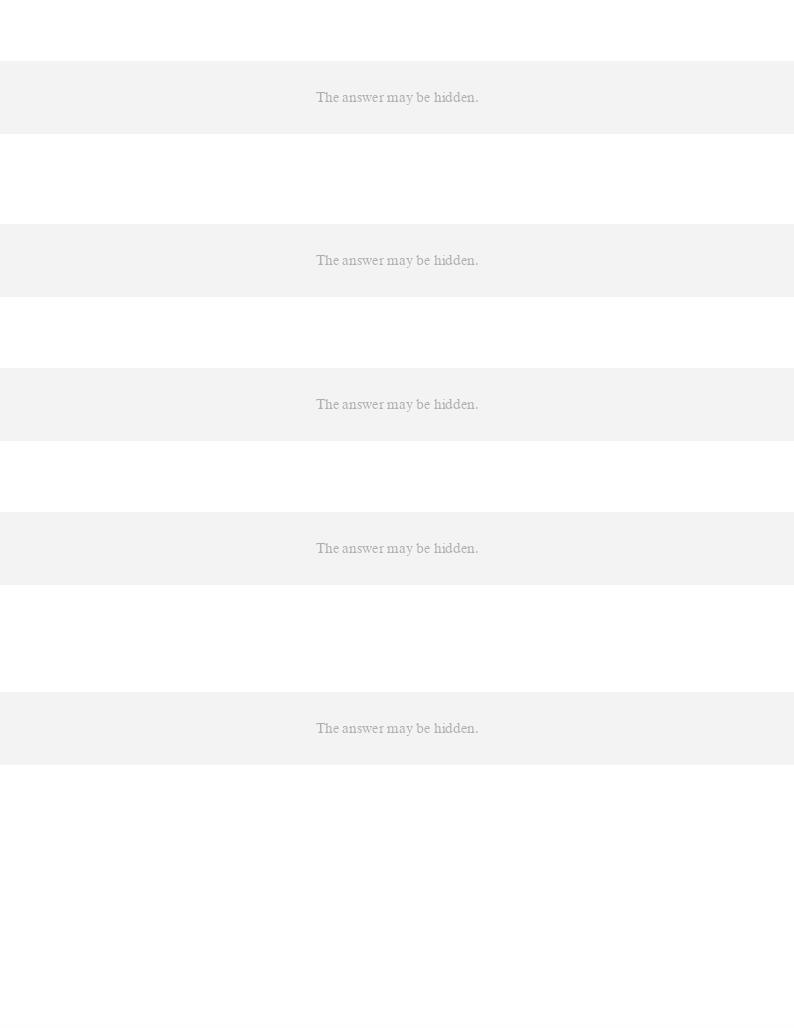
111. Using a perpetual inventory system, the purchase of $30,000 of merchandise on account would include
114. A sales invoice included the following information: merchandise price, $5,000; terms 1/10, n/eom.
Assuming that a credit for merchandise returned of $600 is granted prior to payment, and that the invoice is paid

115. A sales invoice included the following information: merchandise price, $6,000; terms 2/10, n/eom.
Assuming that a credit for merchandise returned of $600 is granted prior to payment, and that the invoice is paid
116. Merchandise subject to terms 1/10, n/30, FOB shipping point, is sold on account to a customer for $17,500.
The seller issued a credit memorandum for $4,000 prior to payment. What is the amount of the cash discount
119. If title to merchandise purchases passes to the buyer when the goods are shipped from the seller, the terms
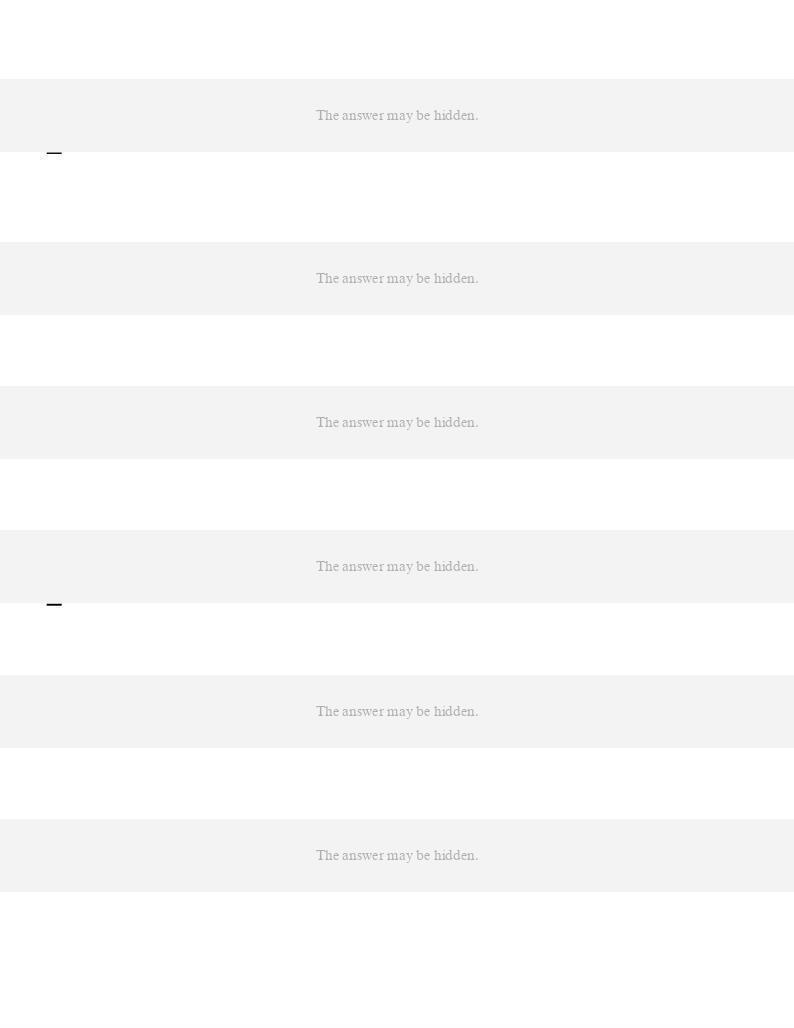
120. If title to merchandise purchases passes to the buyer when the goods are delivered to the buyer, the terms
121. Merchandise with an invoice price of $6,000 is purchased subject to terms of 2/10, n/30, FOB destination.

126. Under the indirect method for preparing the statement of cash flows, increases in current liabilities are
127. Which of the following would not affect the operating activities section of the statement of cash flows,
128. A company has a net income of $39,000 and depreciation expenses of $9,000. During the year, its accounts
payable balance decreased by $5,000. What is the net cash flow from operating activities using the indirect
129. Under the indirect method for preparing the statement of cash flows, decreases in current assets are _____
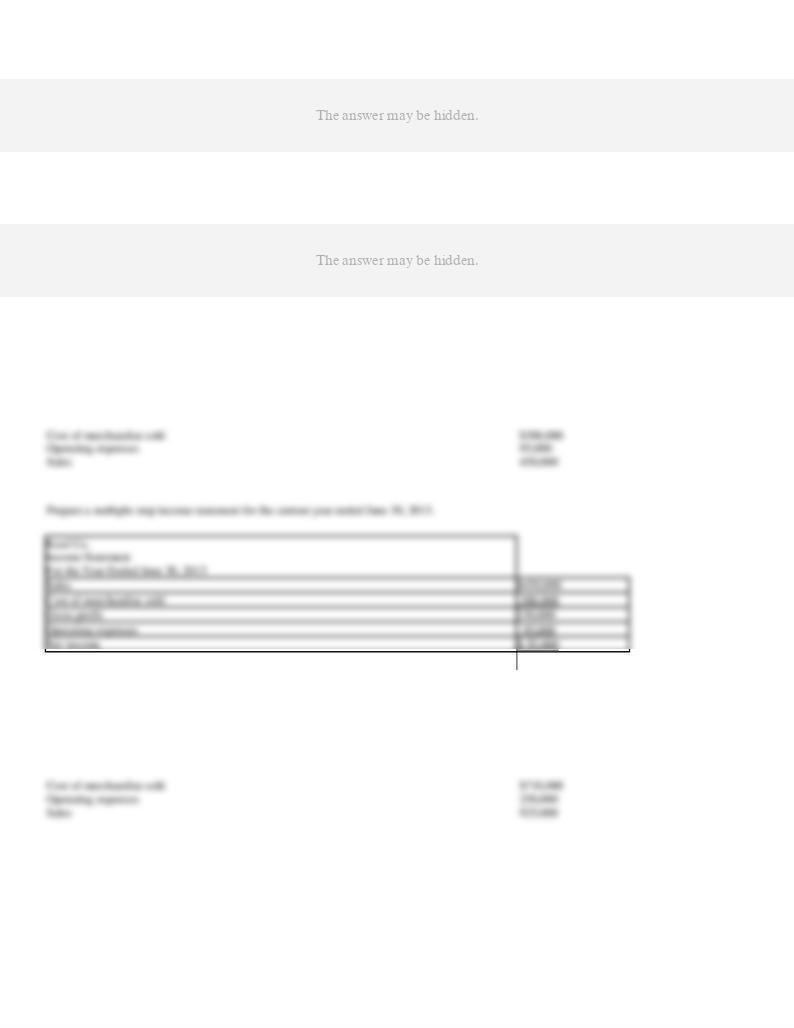
131. ONI, Inc. purchased $60,000 of equipment for cash. How does this transaction impact the statement of
133. The following data for the year ended June 30, 2013, were extracted from the accounting records of Roof
Co.:
134. The following data for the current year ended December 31, 2013, were extracted from the accounting
records of Gilbert Co.:

135. Prepare a multiple-step income statement for Surry Co. from the following data for the year ended
December 31, 2013.
Sales, $915,000; cost of merchandise sold, $670,000; administrative expenses, $30,000; interest expense,
$12,000; rent revenue, $19,000; sales returns and allowances, $55,000; selling expenses, $120,000.
Surry Co.
Income Statement
For the Year Ended December 31, 2013
Revenue from sales:
Sales
$915,000
Less: Sales returns and allowances
55,000
Net sales
$860,000
Cost of merchandise sold
670,000
136. Selected data from the ledger of Wiles Co. after adjustment at June 30, the end of the fiscal year, are listed
as follows:
Accounts Receivable
$39,120
Prepaid Insurance
$ 4,680
Accumulated Depreciation
60,540
Notes Payable
77,750
Administrative Expenses
90,500
Retained Earnings
75,000
Capital Stock
60,000
Salaries Payable
3,060
Cost of Merchandise Sold
655,000
Sales (net)
920,000
Dividends
40,000
Selling Expenses
110,000
Interest Revenue
10,500
Supplies
3,125
Office Equipment
82,700
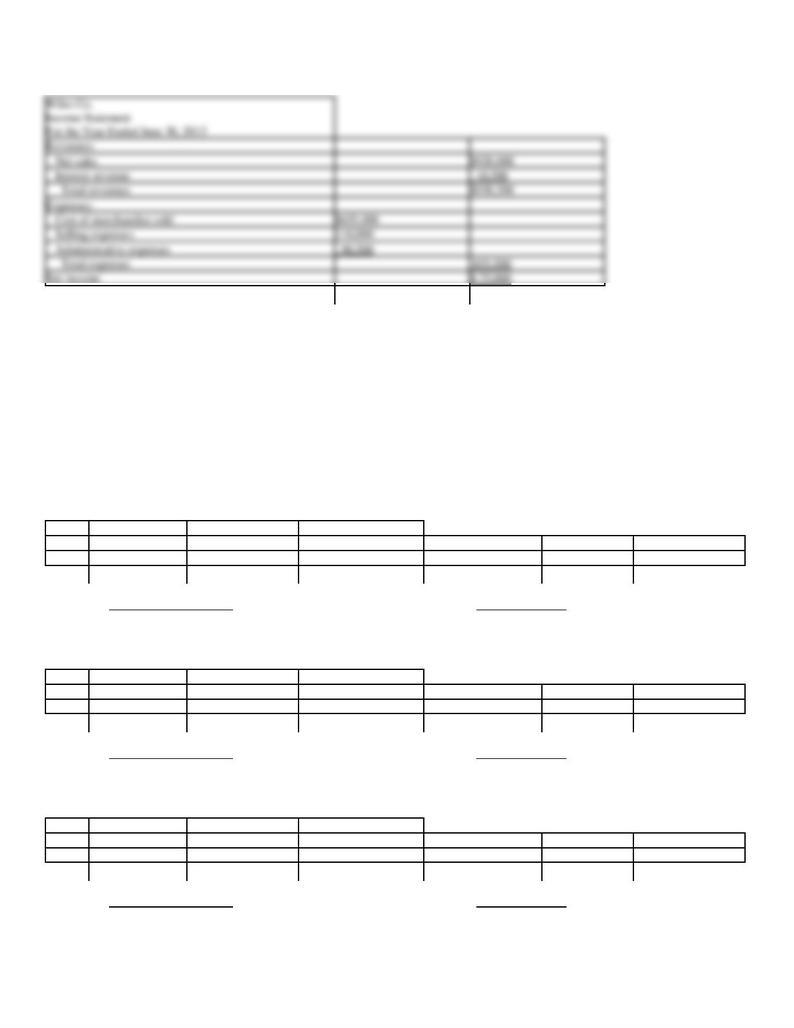
Prepare a single-step income statement for the year ended June 30, 2013.
137. Merchandise with a list price of $7,500 and a cost of $7,000 is sold on account, terms 1/10, n/30. Prior to
payment, merchandise with a list price of $1,000 and a cost of $800 is returned. The correct amount is paid
within the discount period.
Record the following transactions, using the integrated financial statement framework that follows:
(a)
Sold the merchandise.
(b)
Received the returned merchandise
(c)
Received the amount owed.
Assets =
Liabilities
+ Stockholders' Equity
Cash
Accounts Receivable
Merchandise Inventory
Accounts Payable
Capital Stock
Retained Earnings
a.
Statement of Cash Flows
Income Statement
Assets =
Liabilities
+ Stockholders' Equity
Cash
Accounts Receivable
Merchandise Inventory
Accounts Payable
Capital Stock
Retained Earnings
b.
Statement of Cash Flows
Income Statement
Assets =
Liabilities
+ Stockholders' Equity
Cash
Accounts Receivable
Merchandise Inventory
Accounts Payable
Capital Stock
Retained Earnings
c.
Statement of Cash Flows
Income Statement

Assets =
Liabilities
+ Stockholders' Equity
Cash
Accounts Receivable
Merchandise Inventory
Accounts Payable
Capital Stock
Retained Earnings
a.
7,500
-7,000
500
138. Details of invoices for purchases of merchandise are as follows:
Merchandise
Transportation
Terms
Returns and
Allowances
a. $1,000
$25
FOB shipping point, 1/10, n/30
$200
b. 5,000
---
FOB destination, n/30
400
c. 4,000
50
FOB shipping point, 2/10, n/30
150
d. 5,000
---
FOB destination, 1/10, n/30
---
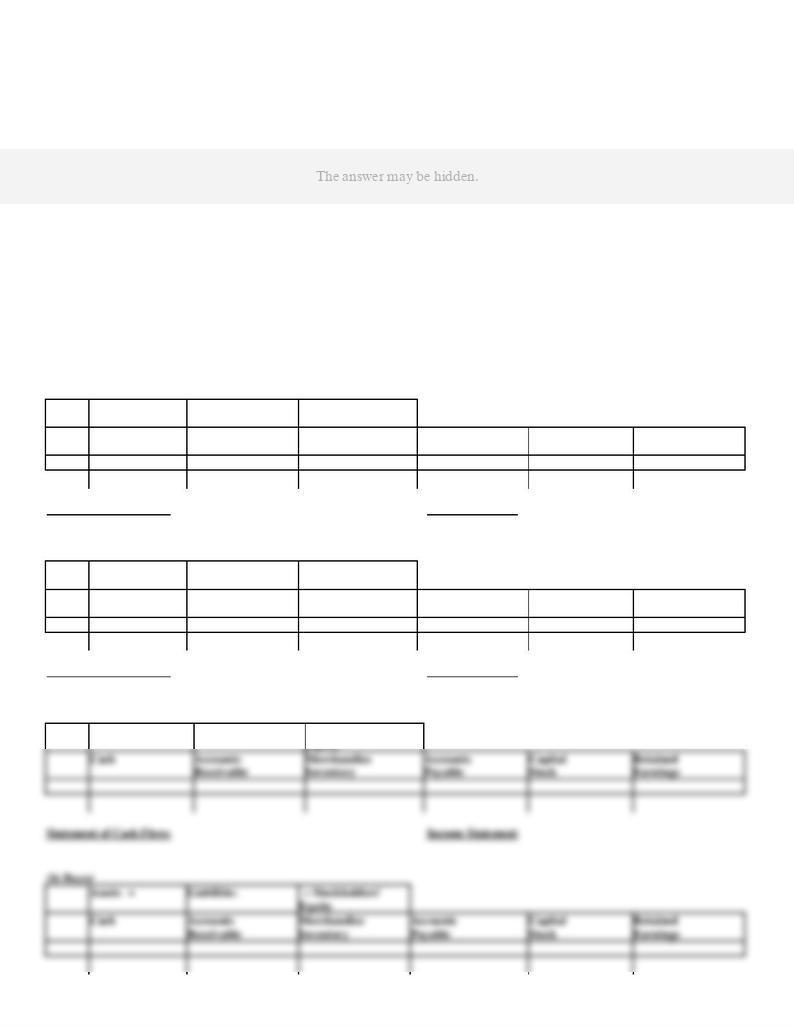
Determine the amount to be paid in full settlement of each of the invoices, assuming that credit for returns and allowances was received prior to
payment and that all invoices were paid within the discount period. Also assume that the seller has prepaid the transportation expenses.
139. Based on the information below, illustrate the effects on the accounts and financial statements of the Seller
and the Buyer. Both use a perpetual inventory system.
(a)
Seller sells Buyer on account merchandise costing $300 for $500, terms 2/10, net 30, FOB destination. The transportation charge is $50.
(b)
Buyer returns as defective $100 worth of the $500 merchandise received. The seller's cost is $60.
(c)
Buyer pays within the discount period.
(a) Seller
Assets =
Liabilities
+ Stockholders'
Equity
Cash
Accounts
Receivable
Merchandise
Inventory
Accounts
Payable
Capital
Stock
Retained
Earnings
Statement of Cash Flows
Income Statement
(a) Buyer
Assets =
Liabilities
+ Stockholders'
Equity
Cash
Accounts
Receivable
Merchandise
Inventory
Accounts
Payable
Capital
Stock
Retained
Earnings
Statement of Cash Flows
Income Statement
(b) Seller
Assets =
Liabilities
+ Stockholders'
Equity
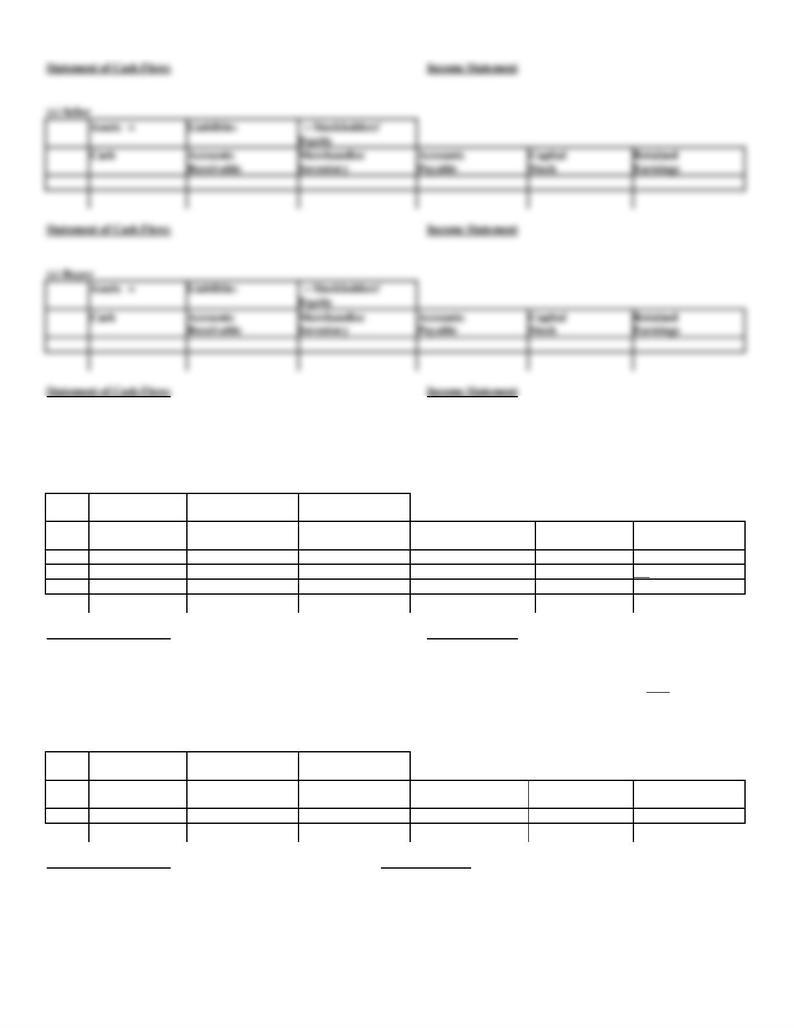
(a) Seller
Assets =
Liabilities
+ Stockholders'
Equity
Cash
Accounts
Receivable
Merchandise
Inventory
Accounts
Payable
Capital
Stock
Retained
Earnings
500
-300
200
-50
150
Statement of Cash Flows
Income Statement
no effect
Sales
500
Cost of Mdse Sold
-300
Delivery Expenses
-50
Effect onNet Income
150
(a) Buyer
Assets =
Liabilities
+ Stockholders'
Equity
Cash
Accounts
Receivable
Merchandise
Inventory
Accounts
Payable
Capital
Stock
Retained
Earnings
500
500
Statement of Cash Flows
Income Statement
no effect
no effect

(b) Seller
Assets =
Liabilities
+ Stockholders'
Equity
Cash
Accounts
Receivable
Merchandise
Inventory
Accounts
Payable
Capital
Stock
Retained
Earnings
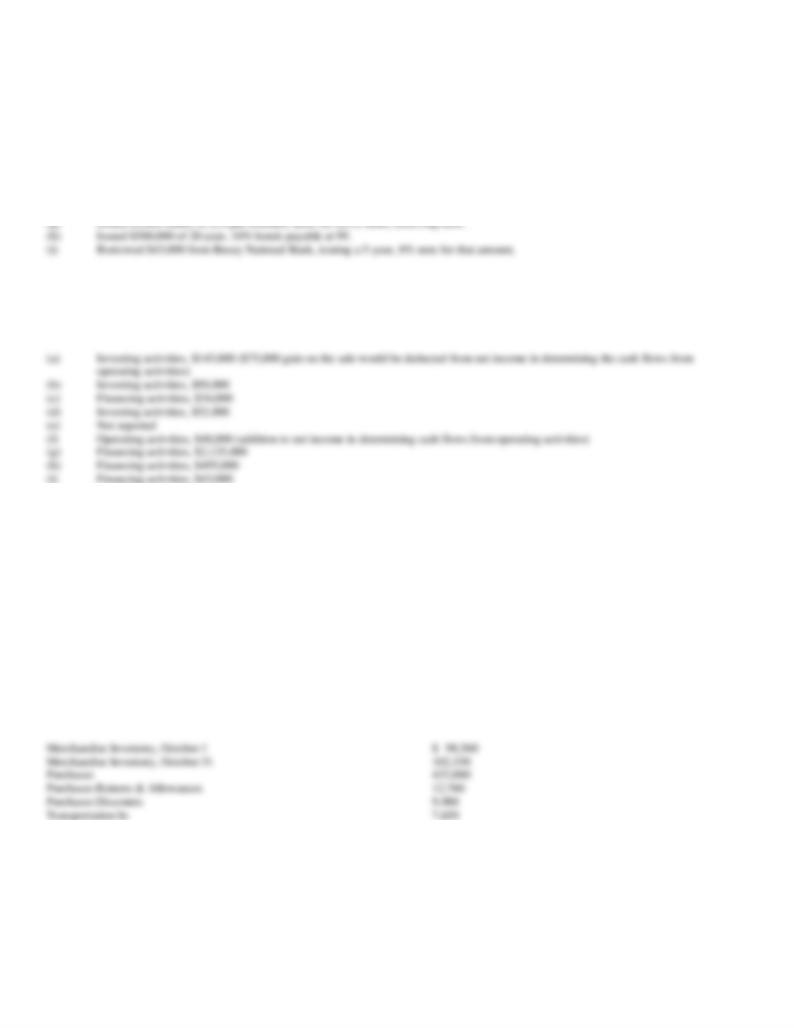
140. State the section(s) of the statement of cash flows prepared by the indirect method (operating activities,
investing activities, financing activities, or not reported) and the amount that would be reported for each of the
following transactions:
(a)
Received $145,000 from the sale of land costing $70,000.
(b)
Purchased investments for $50,000.
(c)
Declared $35,000 cash dividends on stock. $5,000 dividends were payable at the beginning of the year, and $6,000 were payable at the
end of the year.
(d)
Acquired equipment for $32,000 cash.
(e)
Declared and issued 100 shares of $20 par common stock as a stock dividend, when the market price of the stock was $32 a share.
(f)
Recognized by an adjusting entry depreciation for the year, $48,000.
141. Gold Co. sold merchandise to Bronze Co. on account, $23,000, terms 2/15, net 45. The cost of the
merchandise sold is $18,500. Gold Co. issued a credit memorandum for $2,500 for merchandise returned that
originally cost $1,900. Bronze Co. paid the invoice within the discount period. What is the amount of net
income earned by Gold Co. on the transactions?
$3,490 (Net Sales $23,000 - $2,500 - $410) - (Cost of Merchandise Sold $18,500 - $1,900)
142. Based on the following data, determine the cost of merchandise sold for October.
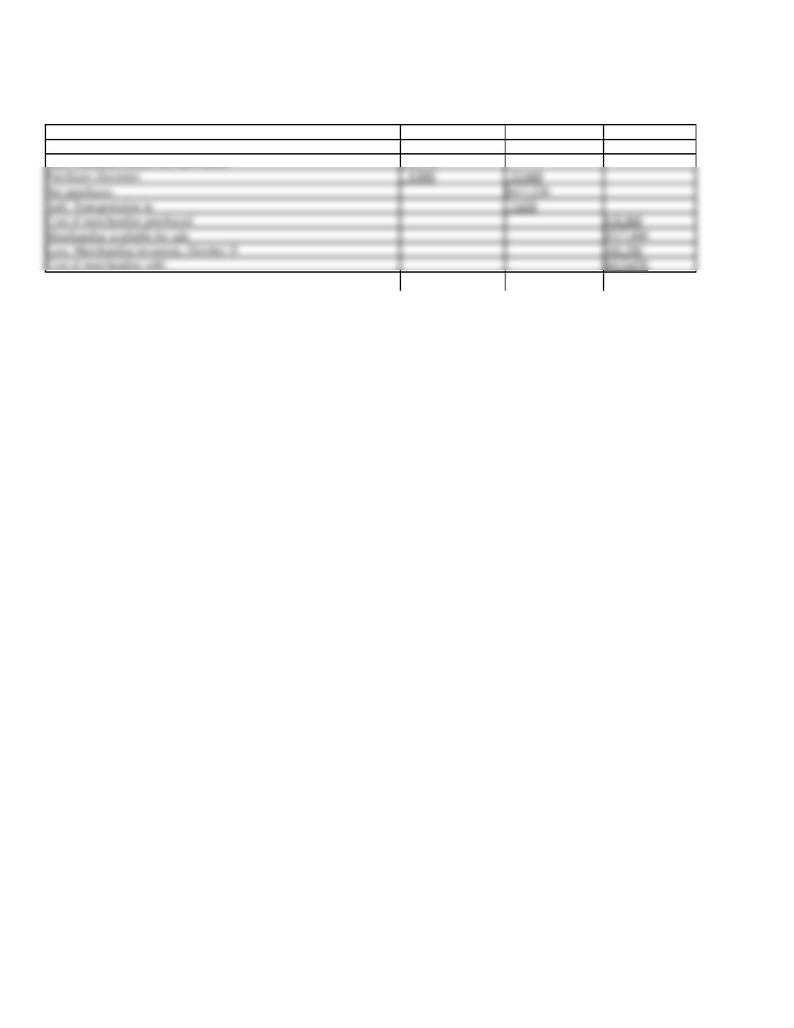
Cost of merchandise sold:
Merchandise Inventory, October 1
$98,560
Purchases
$433,880
Less: Purchases returns and allowances
$12,760